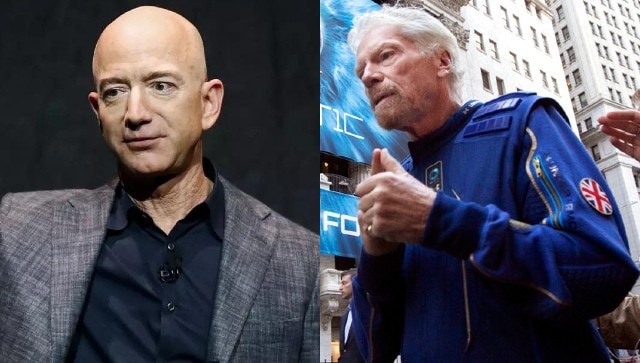
Kenneth Kumar MohantyJul 02, 2021 19:18:10 IST
For space enthusiasts who long dreamed of heading into the final frontier, the wait for decades could come to an end this July. In fact, billionaires Jeff Bezos and Richard Branson are at the cusp of heralding in a new space age — one in which spaceflight comes as close to ordinary humans as it ever has — if they successfully pull off their trips to the edge of space using spacecraft created by their own companies.
Amazon founder Bezos was the first to announce his mission, set for 20 July, but Virgin boss Branson has decided to pip him to the trip with his own now lined up for 11 July. Here’s what you need to know about the billionaires’ planned tryst with the great unknown.
Why are Branson, Bezos’ space trips important?
Space has long been a province with extremely limited access. It has mostly been trained space travellers who have ever been there with just a handful of countries having the capacity anyway to send humans to space and bring them back safely.
But the digital revolution and technological leaps has seen a new class of explorers come to the fore.
The likes of Bezos, Branson, and Tesla and SpaceX boss Elon Musk represent a category of billionaire space enthusiasts who have devoted their considerable wealth to universalise space travel, or at least make it as universal as six-figure or more ticket price would allow it to be. Even so, the approach for these ultra-rich space entrepreneurs has been to make space travel as economical as possible and they have specifically pursued technologies that would dramatically bring down the cost of sending a crewed vessel up into space and getting it safely back down to Earth.
What are the spacecraft they’re using?
The New Shepard vessel on board which Bezos, whose personal fortune stands about a couple of billions short of $200 billion, is heading to space is a reusable rocket system that is designed to allow the booster, or rocket, to be used for multiple trips.
After reaching the pod carrying space travellers to the line where Earth’s atmosphere officially ends and space begins, the booster comes back to the place from where it had been launched. The pod separately heads back after allowing the riders a taste of weightlessness and giving them a view of the Blue Planet’s curvature against the inky black of space. The trip to the edge of space onboard Bezos’s rocket will last all of 11 minutes.
The Virgin Galactic spacecraft works differently. Instead of a rocket and a pod, it has a spaceship, called Unity, and a mothership, christened as Eve. With the spaceship harnessed to it, the mothership takes off from a runway before climbing to a height of 50,000 feet.
“Once past the thickest layers of atmosphere, our ships don’t require huge amounts of fuel to reach space,” Virgin Galactic says, underlining the flight’s “energy-efficient” credentials.
Once at the desired elevation, the mothership releases the spaceship, whose rocket then ignites, “sending the craft up to space” at speed a little over Mach 3. The spaceship finally reaches a height of 300,000 feet, or roughly 90 kilometres, above Earth’s surface, which is when the passengers can experience weightlessness. On the way back, first, “the ship’s wings raise up 60 degrees (and)… after the ship descends to thick atmosphere, the wings are lowered and the pilot glides the spaceship to a smooth landing back on the same runway”.
Who will be Bezos, Branson’s fellow passengers?
Announcing his proposed 20 July trip, Bezos had said, “Ever since I was five years old, I’ve dreamed of travelling to space.” As he heads to fulfil that dream he will be accompanied by three others: his brother Mark and, remarkably, the 82-year-old American aviation icon Wally Funk, who had trained to be an astronaut in the 1960s and will now become the oldest person to fly to space.
The fourth passenger is a mystery figure who has reportedly dished out $28 million in auction to book a seat with Bezos and company on the New Shepard’s maiden human space flight.
Branson, who is worth $5.5 billion, is taking a more technical crew on what he described in a blog post as his company’s “next rocket-powered test flight”. Among the other five members of the flight crew is the Indian-origin Sirisha Bandla, vice president of the company’s government affairs and research operations.
So, when will space flight be open to all?
If Branson is to be believed, space flight for all is already here. Announcing his maiden flight, Branson said that his company has obtained a US Federal Aviation Administration (FAA) approval for a full commercial launch licence and “the pathway towards commercial launch is clear”. However, there are still “tests to come” for Virgin Galactic and Branson will be assessing the astronaut experience on his flight.
But Virgin Galactic’s website has already said that they will this year “be making a limited number of tickets available for future spaceflights”.
As for Bezos’s Blue Origin, its website, too, suggests the company is ready to take passengers to the edge of space. Inviting visitors to “sign up to learn how to reserve your window seat” on its commercial space flights, the website says “details about New Shepard seat sales will be announced soon”.
Post a Comment